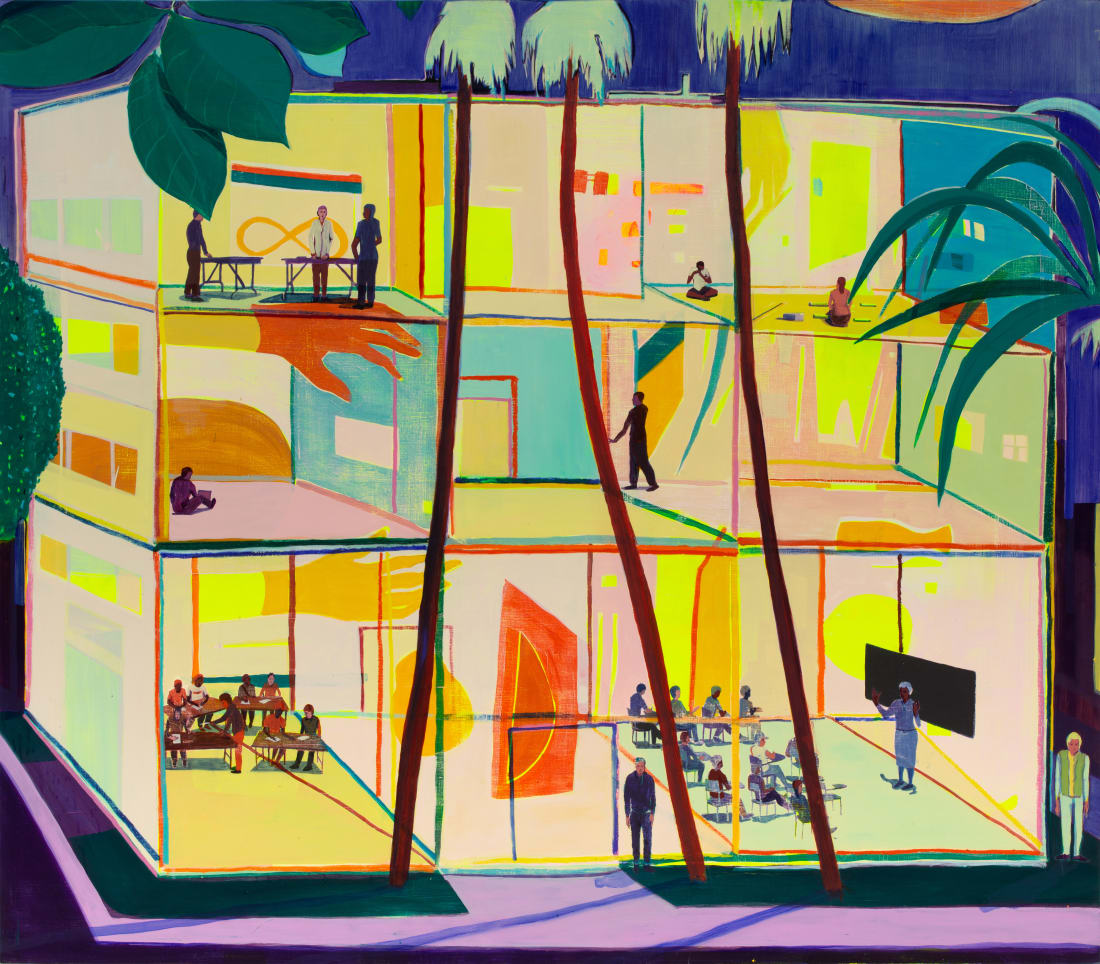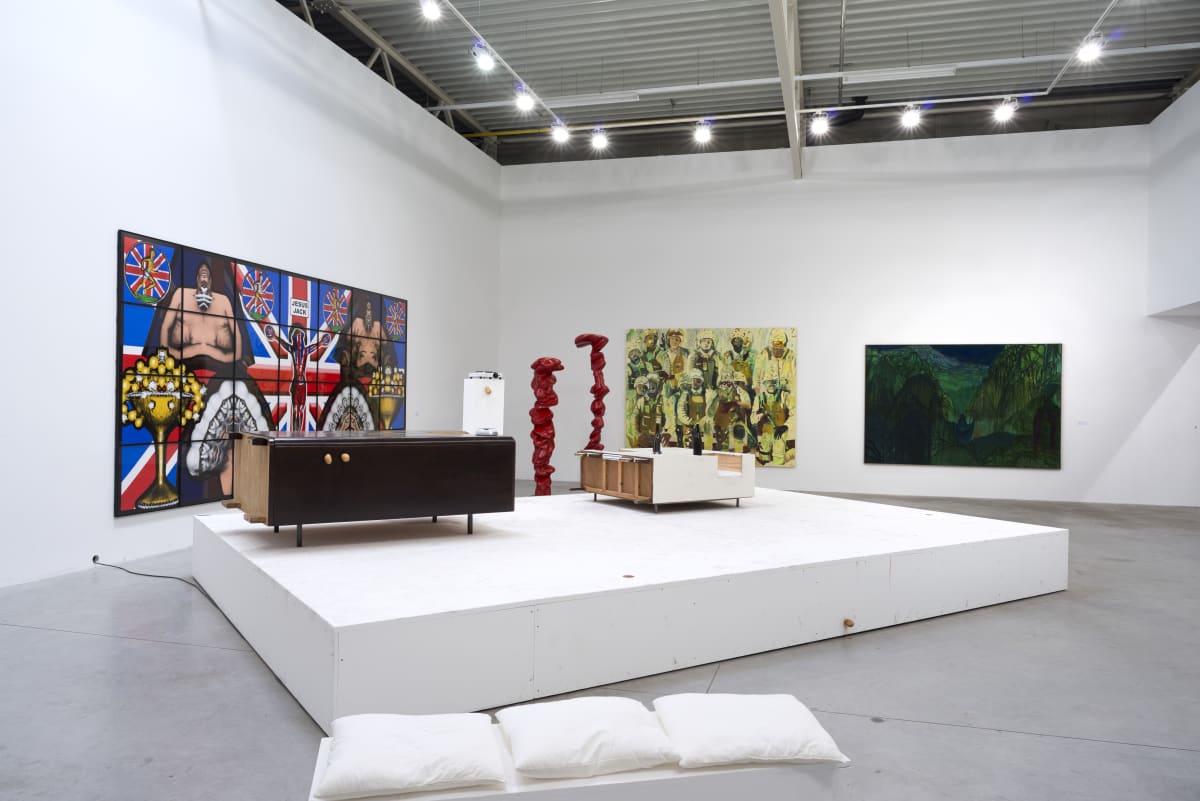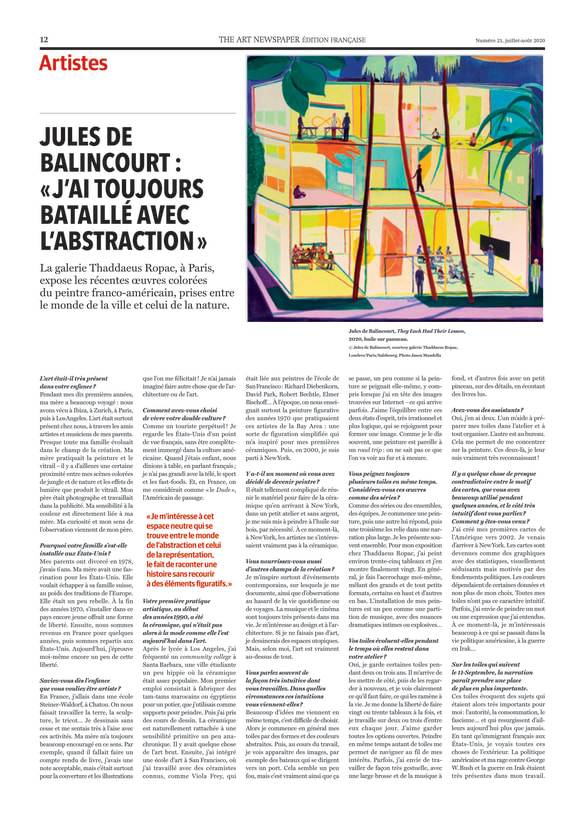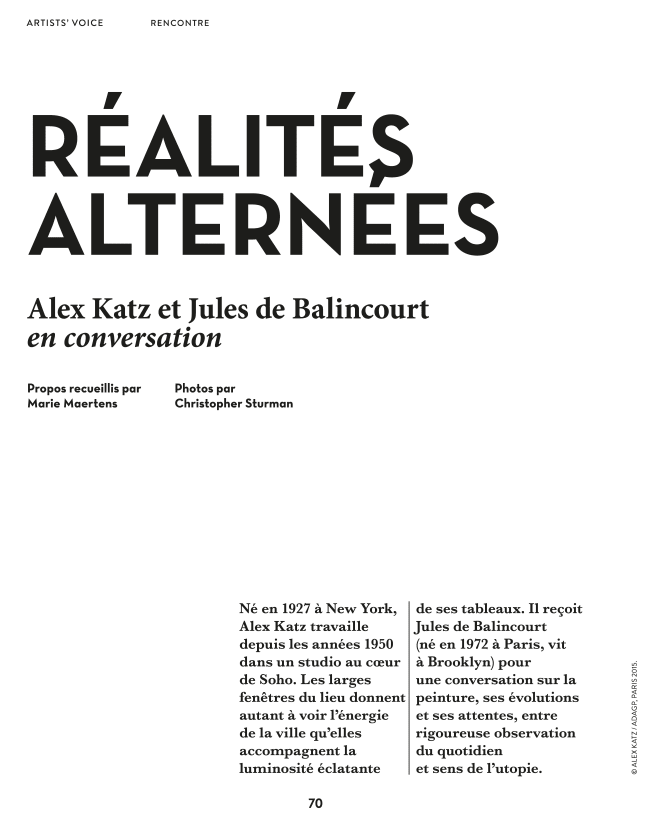
Jules de Balincourt
Overview
'I like the idea of placing the viewer at these crossroads of painting, in which one's emotive response hovers between rational realism or figuration, on the one hand, and the abstract subconscious or primitive on the other.'
Oscillating between utopia and dystopia, Jules de Balincourt's paintings explore indoor and outdoor spaces that suggest ever-changing landscapes - both physical and psychological. His colourful and stylised works evoke cultural and historical narratives, while maintaining a focus on painterly elements. Amalgamating movements such as Pop art, folk art, figuration and abstraction, he unites an array of formal properties in a single dreamlike space.
In the paintings for which he first became known, Balincourt questions power structures, technology and mass media, as well as pop culture stereotypes such as the figure of the lonesome cowboy. Often disguising complex social commentary in seemingly innocuous scenes, his paintings reveal details that undermine or complicate the apparent narrative. In his subsequent map-based works, Balincourt freed himself from any obligation to accurately represent the world in terms of continents, countries, and borders. Attempting instead to convey a more imaginative sense of time and space, the artist reminds us that we also inhabit inner worlds. Verging on the abstract, these images are more symbolic than diagrammatic. A sense of things breaking apart and reconnecting informs his series of works depicting explosions and radiations in bold colours, which become pure fields of energy.
Oscillating between utopia and dystopia, Jules de Balincourt's paintings explore indoor and outdoor spaces that suggest ever-changing landscapes - both physical and psychological. His colourful and stylised works evoke cultural and historical narratives, while maintaining a focus on painterly elements. Amalgamating movements such as Pop art, folk art, figuration and abstraction, he unites an array of formal properties in a single dreamlike space.
In the paintings for which he first became known, Balincourt questions power structures, technology and mass media, as well as pop culture stereotypes such as the figure of the lonesome cowboy. Often disguising complex social commentary in seemingly innocuous scenes, his paintings reveal details that undermine or complicate the apparent narrative. In his subsequent map-based works, Balincourt freed himself from any obligation to accurately represent the world in terms of continents, countries, and borders. Attempting instead to convey a more imaginative sense of time and space, the artist reminds us that we also inhabit inner worlds. Verging on the abstract, these images are more symbolic than diagrammatic. A sense of things breaking apart and reconnecting informs his series of works depicting explosions and radiations in bold colours, which become pure fields of energy.
While retaining a social, cultural and political dimension to his work, in recent years Balincourt has explored the idea of a realm in which indications of specific place or time are absent. This development demonstrates his quest for a more spiritual or existential approach to painting. The juxtaposition of bold colours, as well as the luxuriant presence of nature, recalls the visual characteristics that defined turn-of-the-century Primitivism and the Nabis group, while offering a meditation on the meaning of contemporary life. Inviting us to journey across territories that might be celestial or earthbound, nocturnal or sunlit, the artist often cites the Impressionists and Post-Impressionists as an important influence on his work. However, the Bay Area figurative painters from the 1960s and 1970s, such as Richard Diebenkorn or Elmer Bischoff, had an equally significant role during his formative years in California. His work also reveals the influence of 20th-century American modernists who brought the tradition of landscape painting into the field of abstraction, such as Arthur Dove or Milton Avery.
Born in Paris, Balincourt moved to Los Angeles, California with his family in the early 1980s and graduated from the California College of the Arts in San Francisco. He now splits his time between Brooklyn, New York and Costa Rica. Early in his career, Balincourt participated in significant group exhibitions such as Greater New York at MoMA PS1, Queens, NY (2005); Notre histoire… at the Palais de Tokyo, Paris (2006); Art in America: 300 Years of Innovation at the Guggenheim Bilbao (2007); and USA TODAY at the Royal Academy of Arts, London (2006) and the State Hermitage Museum, Saint Petersburg (2007). He has since had a number of international solo museum exhibitions, including Mori Art Museum, Tokyo (2010); Montreal Museum of Fine Arts, Montreal (2013); Rochechouart Museum of Contemporary Art, Rochechouart (2014); The Modern Art Museum of Fort Worth, Texas (2014-15); Kasseler Kunstverein, Kassel (2015); and participated in the group exhibitions Rehang at Collezione Maramotti, Reggio Emilia, Italy (2019) and Eldorado 3000 with two exhibitions: Les enfants du paradis at MUba Eugène Leroy Tourcoing and Eldorama at Tripostal, Lille, France (2019).
Videos






Artworks
Exhibitions

Publications










































































































































































































